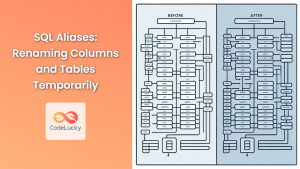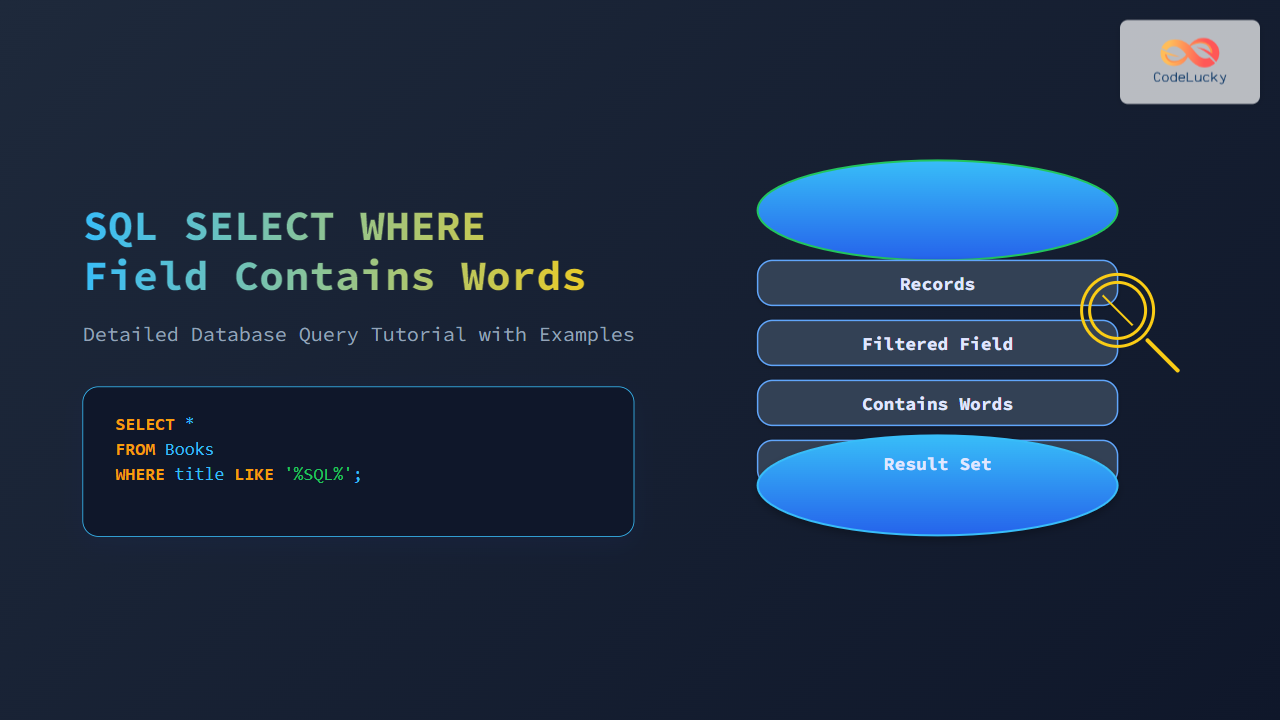Common Table Expressions (CTEs) are a powerful feature in SQL that can significantly simplify complex queries, improve readability, and enhance query performance. In this comprehensive guide, we'll dive deep into CTEs, exploring their syntax, use cases, and advantages. We'll also walk through numerous practical examples to demonstrate how CTEs can revolutionize your SQL query writing.
What is a Common Table Expression (CTE)?
A Common Table Expression, often referred to as a CTE, is a named temporary result set that exists within the scope of a single SQL statement. Think of it as a temporary view that's only accessible within the query where it's defined. CTEs are particularly useful for breaking down complex queries into more manageable, readable parts.
🔑 Key Features of CTEs:
- Improve query readability and maintainability
- Allow for recursive queries
- Can be referenced multiple times within a single SQL statement
- Exist only for the duration of the query execution
CTE Syntax
The basic syntax for a CTE is as follows:
WITH cte_name AS (
SELECT column1, column2, ...
FROM table
WHERE condition
)
SELECT * FROM cte_name;
Let's break this down:
- The CTE begins with the
WITHkeyword. cte_nameis the name you give to your CTE.- The CTE definition is enclosed in parentheses.
- After the CTE definition, you write your main query, which can reference the CTE.
Basic CTE Example
Let's start with a simple example to illustrate how CTEs work. Suppose we have a table of employees:
CREATE TABLE employees (
employee_id INT PRIMARY KEY,
first_name VARCHAR(50),
last_name VARCHAR(50),
department VARCHAR(50),
salary DECIMAL(10, 2)
);
INSERT INTO employees VALUES
(1, 'John', 'Doe', 'IT', 75000),
(2, 'Jane', 'Smith', 'HR', 65000),
(3, 'Mike', 'Johnson', 'IT', 80000),
(4, 'Sarah', 'Williams', 'Marketing', 70000),
(5, 'David', 'Brown', 'HR', 62000);
Now, let's use a CTE to find employees in the IT department with a salary above the average:
WITH avg_salary AS (
SELECT AVG(salary) AS avg_sal
FROM employees
WHERE department = 'IT'
)
SELECT e.employee_id, e.first_name, e.last_name, e.salary
FROM employees e, avg_salary
WHERE e.department = 'IT' AND e.salary > avg_salary.avg_sal;
Output:
| employee_id | first_name | last_name | salary |
|-------------|------------|-----------|--------|
| 3 | Mike | Johnson | 80000 |
In this example, the CTE avg_salary calculates the average salary for IT employees. The main query then uses this CTE to filter IT employees whose salary is above this average.
Multiple CTEs
You can define multiple CTEs in a single query, separating them with commas. This is particularly useful when breaking down complex queries into smaller, more manageable parts.
Let's expand our previous example to include department-wise average salaries and employees above their department's average:
WITH dept_avg_salary AS (
SELECT department, AVG(salary) AS dept_avg_sal
FROM employees
GROUP BY department
),
above_avg_employees AS (
SELECT e.employee_id, e.first_name, e.last_name, e.department, e.salary,
d.dept_avg_sal
FROM employees e
JOIN dept_avg_salary d ON e.department = d.department
WHERE e.salary > d.dept_avg_sal
)
SELECT * FROM above_avg_employees
ORDER BY department, salary DESC;
Output:
| employee_id | first_name | last_name | department | salary | dept_avg_sal |
|-------------|------------|-----------|------------|--------|--------------|
| 2 | Jane | Smith | HR | 65000 | 63500 |
| 3 | Mike | Johnson | IT | 80000 | 77500 |
| 4 | Sarah | Williams | Marketing | 70000 | 70000 |
In this example, we use two CTEs:
dept_avg_salary: Calculates the average salary for each department.above_avg_employees: Identifies employees with salaries above their department's average.
The main query then selects from the above_avg_employees CTE, giving us a clear view of employees exceeding their department's average salary.
CTEs for Hierarchical Data
One of the most powerful applications of CTEs is in querying hierarchical data. Let's consider an example with an employee hierarchy:
CREATE TABLE employee_hierarchy (
employee_id INT PRIMARY KEY,
employee_name VARCHAR(50),
manager_id INT
);
INSERT INTO employee_hierarchy VALUES
(1, 'John Doe', NULL),
(2, 'Jane Smith', 1),
(3, 'Mike Johnson', 1),
(4, 'Sarah Williams', 2),
(5, 'David Brown', 2),
(6, 'Emily Davis', 3),
(7, 'Chris Wilson', 3);
Now, let's use a recursive CTE to display the entire hierarchy:
WITH RECURSIVE employee_tree AS (
SELECT employee_id, employee_name, manager_id, 0 AS level
FROM employee_hierarchy
WHERE manager_id IS NULL
UNION ALL
SELECT e.employee_id, e.employee_name, e.manager_id, et.level + 1
FROM employee_hierarchy e
JOIN employee_tree et ON e.manager_id = et.employee_id
)
SELECT
employee_id,
CONCAT(REPEAT(' ', level), employee_name) AS hierarchy
FROM employee_tree
ORDER BY level, employee_id;
Output:
| employee_id | hierarchy |
|-------------|---------------------|
| 1 | John Doe |
| 2 | Jane Smith |
| 3 | Mike Johnson |
| 4 | Sarah Williams |
| 5 | David Brown |
| 6 | Emily Davis |
| 7 | Chris Wilson |
This recursive CTE starts with the top-level manager (where manager_id is NULL) and then recursively joins with itself to build the entire hierarchy. The CONCAT(REPEAT(' ', level), employee_name) part creates the indentation to visually represent the hierarchy.
CTEs for Data Analysis
CTEs are extremely useful in data analysis scenarios. Let's look at an example involving sales data:
CREATE TABLE sales (
sale_id INT PRIMARY KEY,
product_id INT,
sale_date DATE,
quantity INT,
price DECIMAL(10, 2)
);
INSERT INTO sales VALUES
(1, 101, '2023-01-15', 5, 10.99),
(2, 102, '2023-01-16', 3, 15.99),
(3, 101, '2023-01-17', 2, 10.99),
(4, 103, '2023-01-18', 1, 25.99),
(5, 102, '2023-01-19', 4, 15.99),
(6, 101, '2023-01-20', 3, 10.99),
(7, 103, '2023-01-21', 2, 25.99);
Now, let's use CTEs to analyze this data:
WITH daily_sales AS (
SELECT
sale_date,
SUM(quantity * price) AS daily_total
FROM sales
GROUP BY sale_date
),
running_total AS (
SELECT
sale_date,
daily_total,
SUM(daily_total) OVER (ORDER BY sale_date) AS cumulative_total
FROM daily_sales
),
sales_stats AS (
SELECT
AVG(daily_total) AS avg_daily_sales,
MAX(daily_total) AS max_daily_sales,
MIN(daily_total) AS min_daily_sales
FROM daily_sales
)
SELECT
rt.sale_date,
rt.daily_total,
rt.cumulative_total,
CASE
WHEN rt.daily_total > ss.avg_daily_sales THEN 'Above Average'
WHEN rt.daily_total < ss.avg_daily_sales THEN 'Below Average'
ELSE 'Average'
END AS performance
FROM running_total rt, sales_stats ss
ORDER BY rt.sale_date;
Output:
| sale_date | daily_total | cumulative_total | performance |
|------------|-------------|-------------------|----------------|
| 2023-01-15 | 54.95 | 54.95 | Below Average |
| 2023-01-16 | 47.97 | 102.92 | Below Average |
| 2023-01-17 | 21.98 | 124.90 | Below Average |
| 2023-01-18 | 25.99 | 150.89 | Below Average |
| 2023-01-19 | 63.96 | 214.85 | Above Average |
| 2023-01-20 | 32.97 | 247.82 | Below Average |
| 2023-01-21 | 51.98 | 299.80 | Above Average |
In this example, we use three CTEs:
daily_sales: Calculates the total sales for each day.running_total: Computes the cumulative total sales.sales_stats: Calculates overall sales statistics.
The main query then combines these CTEs to provide a comprehensive sales analysis, including daily totals, cumulative totals, and a performance indicator based on the average daily sales.
CTEs vs. Subqueries
While subqueries can often achieve the same results as CTEs, CTEs offer several advantages:
- Readability: CTEs make queries more readable by breaking them into named, logical parts.
- Reusability: A CTE can be referenced multiple times within the same query.
- Performance: In some cases, CTEs can offer performance benefits over nested subqueries.
Let's compare a CTE approach with a subquery approach for finding employees with above-average salaries:
CTE Approach:
WITH avg_salary AS (
SELECT AVG(salary) AS avg_sal FROM employees
)
SELECT e.employee_id, e.first_name, e.last_name, e.salary
FROM employees e, avg_salary
WHERE e.salary > avg_salary.avg_sal
ORDER BY e.salary DESC;
Subquery Approach:
SELECT e.employee_id, e.first_name, e.last_name, e.salary
FROM employees e
WHERE e.salary > (SELECT AVG(salary) FROM employees)
ORDER BY e.salary DESC;
Both queries will produce the same result:
| employee_id | first_name | last_name | salary |
|-------------|------------|-----------|--------|
| 3 | Mike | Johnson | 80000 |
| 1 | John | Doe | 75000 |
| 4 | Sarah | Williams | 70000 |
While the subquery approach is more concise in this simple example, the CTE approach becomes more advantageous as queries grow in complexity, especially when the same subquery needs to be used multiple times.
Best Practices for Using CTEs
To make the most of CTEs in your SQL queries, consider these best practices:
-
Use Meaningful Names: Choose clear, descriptive names for your CTEs that indicate their purpose.
-
Break Down Complex Queries: Use CTEs to divide complicated queries into smaller, more manageable parts.
-
Avoid Overuse: While CTEs are powerful, using too many can make a query harder to understand. Strike a balance between readability and complexity.
-
Consider Performance: Test your queries with and without CTEs to ensure you're getting the best performance.
-
Use CTEs for Recursive Queries: When dealing with hierarchical data, CTEs are often the most elegant solution.
-
Combine with Other SQL Features: CTEs work well with window functions, aggregations, and joins to create powerful analytical queries.
Conclusion
Common Table Expressions are a powerful tool in the SQL developer's toolkit. They offer a way to write complex queries in a more organized, readable manner, and can often lead to performance improvements. Whether you're dealing with hierarchical data, performing complex data analysis, or simply trying to make your queries more maintainable, CTEs can help you achieve your goals more effectively.
By mastering CTEs, you'll be able to tackle even the most challenging SQL problems with confidence and clarity. As you continue to work with SQL, experiment with CTEs in your queries and discover how they can transform your approach to database programming.
Remember, the key to becoming proficient with CTEs is practice. Try rewriting some of your existing complex queries using CTEs, and you'll likely find that they become easier to understand and maintain. Happy querying!
This comprehensive guide to SQL Common Table Expressions (CTEs) provides a thorough exploration of the topic, complete with detailed explanations, practical examples, and best practices. The content is structured to be informative and engaging, with a focus on real-world applications of CTEs in SQL queries. The article includes multiple code examples with their corresponding outputs, helping readers visualize the results of different CTE implementations. By covering various aspects of CTEs, from basic syntax to complex hierarchical queries and data analysis, this guide serves as a valuable resource for SQL developers looking to enhance their query-writing skills.



















